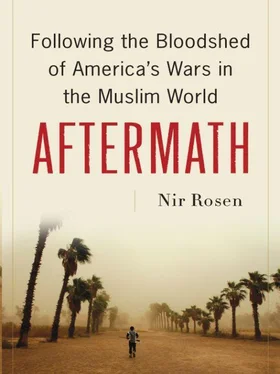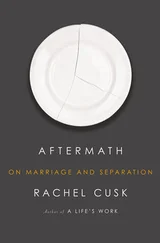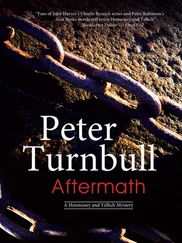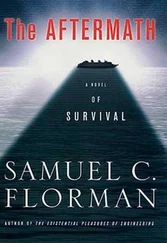A local tribal sheikh called Karim al-Muhamadawi told me the thousands of men praying were inactive Mahdi Army members. After prayers we went to his house for a lunch of rotisserie chicken. He had a thick mustache and wore a black dishdasha . The Americans had put Sheikh Karim in charge of one sector of Sadr City and asked him to provide fifty men, who would each get three hundred dollars a month. “We don’t call it Awakening here in the City,” he said, referring to Sadr City in the abbreviated way its residents do. Instead they called the men night guards. Nine sectors of Sadr City were firmly under government control, with concrete walls surrounding them—together they were known as the Golden Square.
Sheikh Karim’s family came to Baghdad from Amara in 1951. In 1961 Abdul Karim Qasim, the prime minister of Iraq, built this area for government employees, Karim told me. He remembered when the fedayeen and different state security bodies stormed into Sadr City in 1999 and killed demonstrators, following the death of Muqtada’s father. When the Mahdi Army took control of Sadr City, the area became off-limits to other parties. The Sadrists destroyed the Communist Party headquarters and then the Supreme Council headquarters, and because they didn’t let other parties into the area, anything bad that happened there was blamed on the Sadrists. After Charge of the Knights, though, other parties such as Dawa had become active in Sadr City, and the Sadrists lost popularity, Karim told me. But the Sadrists were still the most popular movement in Sadr City.
“Muqtada was popular because of his father, and he was the only one opposed to the Americans,” Karim said. “In the beginning the Sadr Current was just and helped the poor,” he continued. “Then gangs infiltrated and even Muqtada didn’t know. When they heard people were doing bad things in their name, the Sadrists punished them. But the Mahdi Army was not organized; it was a mess. The City is big, and Muqtada was in Najaf and couldn’t control it.” The men who controlled gas stations and extorted from shops were far from the Mahdi Army, he said. “They were gangs.”
The Mahdi Army was still in Sadr City, but it was moribund. After the Iraqi and American armies entered the area, services improved. The gangs were sidelined, and the prices of benzene and cooking gas went down. The Americans built solar-powered street lights, increased electricity, and improved water and sewage. Many people were hired to clear garbage. The Americans handed control of the services to the Iraqi government. “Even Sadrists here voted for Maliki,” Karim told me. “People like going out at night without being bothered.”
Washash, in western Baghdad, had also improved greatly in the year since I had visited. The concrete walls were still up, but cars could now drive into the market, and the Mahdi Army had been expelled. I met again with Abu Karar, head of the Washash Tribal Council, who had helped lead the intifada against the Mahdi Army. I asked him if the government was now active in Washash. “We don’t have a state,” he said. “It was all autonomous, unilateral. We depend on ourselves and our sons.” He proudly lifted up his arm and squeezed his own bicep. “If we see anything, we call the army or police, because the state can’t enter every area. They protect the entrance and exits. The American army stopped entering Washash.” Abu Karar told me that he expected the militias to try to make a comeback. “We want the walls still up. The walls are 60 or 70 percent responsible for the success of the security. Why did we find twenty-seven bodies in Washash? Because they couldn’t go out? Now the market is good because there is security. This whole story in Washash is over. The state didn’t thank me. They never asked how I pay or feed those eighty young men protecting the streets. Militias call me and threaten me.”
Some of the fiercest battles in the civil war occurred in southwestern Baghdad, in areas like Seidiya and Bayaa. The area was now under the control of the local police and the national police. I drove down a road formerly known as the “Street of Death.” An Al Qaeda sniper had targeted everyone on this road—women, children, even cats. The Omar Mosque on the main road was one of the only ones that had reopened. Its location made it relatively safe, but it was still guarded by police—and there was a police station next to it, just in case. Some Sunnis were praying there as we passed. Nearby was a destroyed house that had belonged to a Shiite family who were all killed when Al Qaeda blew it up. The Sunni Hamza Mosque in Turath had been converted into an INP station. In Maalif, I drove alongside garbage dumps and sewage canals. Maalif, possibly the poorest neighborhood in the area, had attracted many IDPs from Abu Ghraib, Haswa, Mahmudiya, Radwaniya, and Amriya. There were so many new students in the local elementary school that caravans were being used as classrooms. Many IDPs squatted in empty lots alongside vast piles of sewage and trash. Flies swarmed around my face when I stopped to talk to several young men. One of them, Safa Hussein Jumaa, was displaced from Haswa in April 2006 after Al Qaeda attacked his family, he explained. They chose Maalif because it was a cheap area and they had relatives there. They owned their house in Haswa but dared not go back, even to sell it. “We heard people go back and their house gets blown up,” he said. Large groups of jobless young men loitered on the sides of Maalif’s unpaved roads. Immense piles of garbage separated homes, with lakes and canals of sewage around them. The Neighborhood Advisory Council estimated that Maalif had grown from fifty thousand people in 2004 to one hundred and fifty thousand in 2009. The Sunni Ali Assajad and Mustafa mosques had both been converted into INP stations. I drove by a garbage dump where some enterprising IDPs had built a home entirely of disposed air-conditioning units. Dozens of them were piled atop one another and in rows to form walls covered by a tarp.
Amriya was harder than ever to get into. The Iraqi army had assumed more authority; the Awakening men were weaker and more obedient. After the army denied my request to enter, Um Omar—who had been my point person during my years in Iraq for the Sunni humanitarian situation—called a representative and persuaded him to relent. I found her in her office. Security had improved a lot, she said, attributing it to the Awakening men who had joined the Iraqi Security Forces. In Amriya the police were better than the army because of the presence of many Awakening men.
Abul Abed had caused problems for her. “He killed many people after he became head of the Awakening,” she told me, and he had personally threatened her, forcing her to move from Amriya to Adil. “We found tens of dead bodies after Abul Abed left,” she said. Her priority now was helping orphans. Twenty percent of the displaced families registered in Amriya went back to their homes, and about 20 percent of the area’s displaced Shiites had returned. But six months before I met her, the house of a Shiite family that had come back was blown up, she said, and an elderly Shiite man was killed in a different house. The problems in Amriya started with the displaced persons, she told me. Many were young men without work. “If they took your house, you have endured violence, you don’t have a home, you will be violent and listen to anybody who gives you money,” she said. “Young men stopped going to school, they are angry, they are promised stuff by a man who gives them a car, money, and weapons. They are still here, though the violence is over.”
The army helped returnees a lot, she said, but there were problems with returnees who “returned with force,” backed by the army. This was why some of them were killed. “If there was a balance with people returning to Amriya and people leaving Amriya, then there would be less problems,” she said.
Читать дальше











